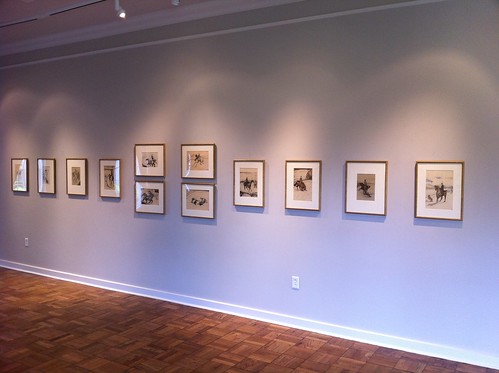Toulouse-Lautrec in the Bradley Family Foundation Collection
Harry and Peg Bradley collected nearly 40 works by Toulouse-Lautrec between 1950 and 1955, a period of intense interest in the artist's work in the United States. This interest coincided with the fiftieth anniversary of his death. A. Hyatt Mayor, writing in The Metropolitan Museum of Art Bulletin in November 1951, observed that Toulouse-Lautrec’s sense of aristocratic detachment coupled with his intense empathy—his ability to be both knowing and candid—made him “the artist of our day.”
Toulouse-Lautrec’s mid-century popularity was fuelled by the publication of Pierre La Mure’s novel about the artist’s life, Moulin Rouge (1950), Peter Riethof’s film, Toulouse-Lautrec Painter of the Parisian Bohème (1951), and John Huston’s film adaptation of the La Mure novel (1952). Works by Toulouse-Lautrec were reproduced in national magazines such as Newsweek: it was the dawn of the golden age of advertising and the artist’s bold and groundbreaking posters, advertising everything from bicycle chains to chanteuses, were increasingly admired.
The Metropolitan Museum had works by Toulouse-Lautrec on display in the print galleries in 1951 to commemorate the anniversary (many of their best lithographs had come from the estate of Alfred Stieglitz), and a small exhibition, from the collection of Mr. and Mrs. John Davies Stamm of New York, landed at the Milwaukee Art Institute in late 1954. There was a major show at the Philadelphia Museum of Art in 1955 (where Harry Bradley purchased thirteen posters) that then traveled to the Chicago Art Institute and the Museum of Modern Art the following year. MoMA added extra hours to its schedule to accommodate the crowds during the first week. In addition to the Philadelphia purchases, the Bradleys bought their Toulouse-Lautrec works from at least four New York galleries: Fine Arts Associates, French & Company, M. Knoedler & Co., and Kleeman Galleries. Knoedler had shown Toulouse-Lautrec lithographs from the collection of Ludwig Charell in 1950 to benefit the Musee d'Albi, the Toulouse-Lautrec museum.
Of the many works by Toulouse-Lautrec that the Bradleys purchased, several went to the Milwaukee Art Museum, several hung at the various Zita’s locations (where, according to a newspaper article, art could be found in Mrs. Bradley’s “private office, in dressing rooms, in halls and even in the stock room”) and others remained in the Bradley Family Foundation Collection. Some of these works were originals, and some were reproductions; among them was a suite of 22 prints from the two volumes known as Au Cirque (At the Circus) purchased in 1951. Taken from a series of 39 drawings Toulouse-Lautrec made from memory in 1899 while confined to the St. James Clinic in Neuilly for his alcoholism, these lithographic reproductions were family favorites, hanging at Lynden and at Jane Bradley Pettit’s home.
Many lithographic reproductions of the drawings were made over the years, beginning around the turn of the century, and this group of prints appears to come from at least two different editions. The majority bear the imprint of the Librairie de France. Goupil published an edition that included 22 drawings (Volume I) in 1905; Librairie de France published the remaining 17 drawings as Volume II around 1913. In 1932 Librairie de Fance published an edition of 200 of the complete set; the plates were made by their studio.
Also on view are posters of two café-concert performers, May Milton and May Belfort. As “the premier poster artist of Paris,” the artist who “created the modern poster,” Toulouse-Lautrec was in great demand to advertise famous performers. Toulouse-Lautrec’s posters of fin-de-siècle Paris’s demi-monde are heavily influenced by Japanese prints, particularly the ukiyo-e prints that depicted the “floating world” of actors and courtesans of Edo-period Japan. He was drawn to the “…strong outlines, silhouettes, cropped compositions, and oblique angles” of the Japanese woodblock prints (May Belfort is said to resemble a cross-dressed male actor in a print by Utagawa Kuniyasu) but produced distinct portraits of recognizable individuals. “The agility of his line surprises like Hokusai’s,” writes Mayor, “though his insight penetrates instead of glancing off into routine caricature like the Japanese.”
Much of the specific information about Toulouse-Lautrec’s work, above, comes from these two sources:
Michael, Cora. “Henri de Toulouse-Lautrec (1864-1901)”. In Heilbrunn Timeline of Art History. New York: The Metropolitan Museum of Art, 2000-. http://www.metmuseum.org/toah/hd/laut/hd_laut.htm (May 2010).
Mayor, A. Hyatt. “Toulouse-Lautrec.” Metropolitan Museum of Art Bulletin, New ser., v. 10, no. 3 (November, 1951): 89-95.

